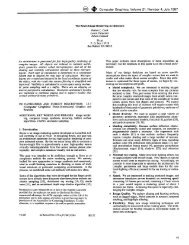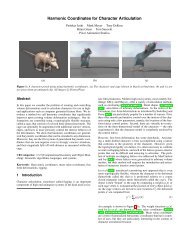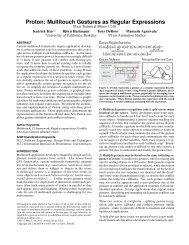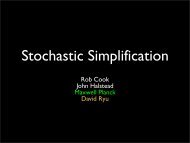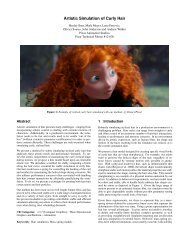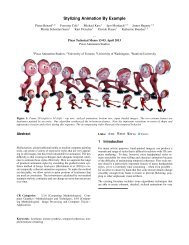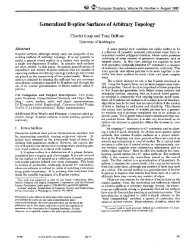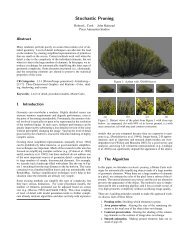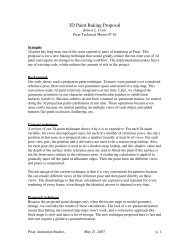Correlated Multi-Jittered Sampling - Pixar Graphics Technologies
Correlated Multi-Jittered Sampling - Pixar Graphics Technologies
Correlated Multi-Jittered Sampling - Pixar Graphics Technologies
You also want an ePaper? Increase the reach of your titles
YUMPU automatically turns print PDFs into web optimized ePapers that Google loves.
However, jittering suers when these samples are projected onto the X- or<br />
Y-axis. In this case, we eectively have only m or n strata rather than N. This<br />
can greatly increase the variance at edges, especially when they are nearly axisaligned.<br />
The N-rooks sampling pattern xes this by jittering independently in<br />
each dimension, shuing the samples from one of the dimensions, and then<br />
pairing the samples from each dimension. This gives the full N strata when<br />
projecting onto an axis, but may result in more clumping in 2D.<br />
Chiu et al’s multi-jittered sample pattern achieves both of these properties<br />
simultaneously. Each cell and each horizontal or vertical substratum is occupied<br />
by a single jittered sample. Their method for producing these samples<br />
begins by placing them in an ordered, “canonical” arrangement as shown in<br />
Figure 1:<br />
P. Shirley. Discrepancy as a quality measure for<br />
sample distributions. In Eurographics ’91, pages<br />
183–193, September 1991.<br />
Listing 1: Producing the canonical arrangement.<br />
for (int j = 0; j < n; ++j) {<br />
for (int i = 0; i < m; ++i) {<br />
p[j * m + i].x = (i + (j + drand48()) / n) / m;<br />
p[j * m + i].y = (j + (i + drand48()) / m) / n;<br />
}<br />
}<br />
The next step shues the arrangement. First, the X coordinates in each<br />
column of 2D cells are shued. Then, the Y coordinates in each row are shuf-<br />
ed:<br />
Figure 1: The canonical arrangement. Heavy<br />
lines show the boundaries of the 2D jitter cells.<br />
Light lines show the horizontal and vertical substrata<br />
of N-rooks sampling. Samples are jittered<br />
within the subcells.<br />
Listing 2: Shuing the canonical arrangement.<br />
for (int j = 0; j < n; ++j) {<br />
for (int i = 0; i < m; ++i) {<br />
<br />
int k = j + drand48() * (n - j);<br />
<br />
std::swap(p[j * m + i].x,<br />
<br />
p[k * m + i].x);<br />
}<br />
}<br />
for (int i = 0; i < m; ++i) {<br />
for (int j = 0; j < n; ++j) {<br />
<br />
int k = i + drand48() * (m - i);<br />
<br />
std::swap(p[j * m + i].y,<br />
<br />
p[j * m + k].y);<br />
}<br />
}<br />
Figure 2 shows an example of the result. The shue preserves the 2D jitter<br />
and the N-rooks properties of the original canonical arrangement. The result<br />
is slightly better than plain jitter, but still shows a degree of clumpiness and<br />
unevenness in the distribution of samples.<br />
<strong>Correlated</strong> <strong>Multi</strong>-<strong>Jittered</strong> <strong>Sampling</strong><br />
Figure 2: A multi-jittered sampling pattern.<br />
Our key observation is that a small tweak to the shuing strategy can make a<br />
dramatic improvement to the sample distribution: apply the same shue to<br />
the X coordinates in each column, and apply the same shue to the Y coordinates<br />
in each row. Listing 2 can be trivially changed to accomplish this simply<br />
by exchanging line 2 with 3, and line 9 with 10.<br />
This change greatly reduces the clumpiness as shown by the example pattern<br />
in Figure 3. There is a still a randomness to the position of the samples<br />
but they are much more evenly distributed throughout the unit square. The<br />
correlation in the shues means that each sample is now roughly /m apart<br />
2<br />
Figure 3: With correlated shuing.



